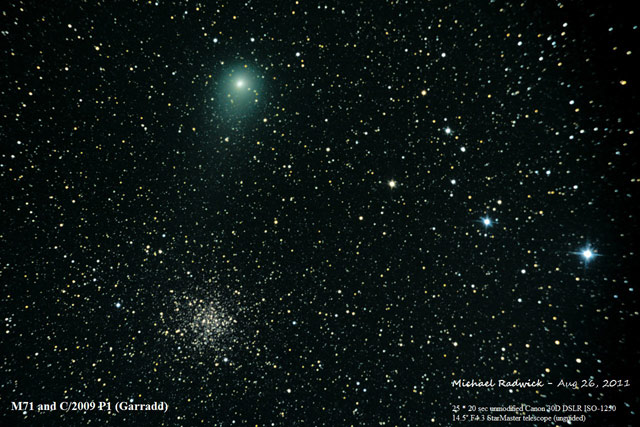


Here is a photo of M71 plus one of your favorite kinds of ice-ball objects in the same field of view. Here are some notes about the image:
This photo was taken while helping out at the Scio Farms Estates public event on Aug 26, 2011 using my unmodified Canon 30D DLSR camera and 14.5” F4.3 StarMaster telescope. The image consists of 25 images, each exposed for 20 seconds, and combined using a free program called Deep-Sky-Stacker. The telescope was unguided and the camera was operated manually (meaning no computers were used). I basically stuck the camera in the scope and clicked away for about 20 minutes (10:50pm - 11:20pm EDT).
We set up our telescopes at about 8:30pm while being attacked by hoards of mosquitoes. The little vampires were so bad that we were literally breathing and eating them. Lots of spray was used to deter them a little bit. Fortunately, the temperature cooled down from 80F to about 65F by 11pm, which slowed them down.
However, the humidity was pretty high, and the lower temperature produced a lot of dew. I had to keep eye-pieces covered up to prevent them from fogging over. My feet were soaked by the end of the night. The sky itself was only fair, bands of clouds appeared and disappeared during the night, but was otherwise clear. I would rate the seeing only 6-7 of 10 (occasional strong flicking of stars).
The image shows two separate objects: a Globular Cluster known as M71 (lower-left), and a comet called C/2009 P1 (Garradd) (upper-left).
Per Wikipedia, M71 was discovered in 1746 by Philippe Loys de Cheseaux, and included by Charles Messier in his catalog in 1780. M71 is about 12,000 light years away and is about 27 light years across. M71 is a relatively easy object to observe from the constellation Sagitta.
The comet, discovered by Gordon Garradd in Aug 2009, is much, much closer to us than M71 (being found in our own solar-system). It was about 1.4 AU (0.000022 light years or 130 million miles) from Earth at the time the photo was taken. It is on an orbit which currently approaching our sun and will obtain perihelion (closest to the sun) on Dec 23, 2011. The comet is expect to continue to brighten through March 2012. The orbit calculation shows it is on a hyperbolic path that may fling the comet completely out of the solar system, never to be seen again, but should be observable from the Northern Hemisphere for about two years.
Clear Skies,
Mike Radwick